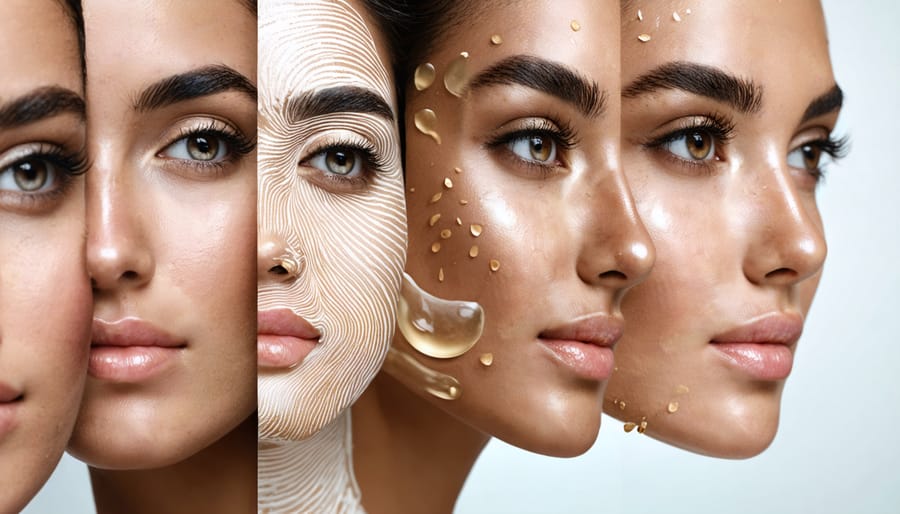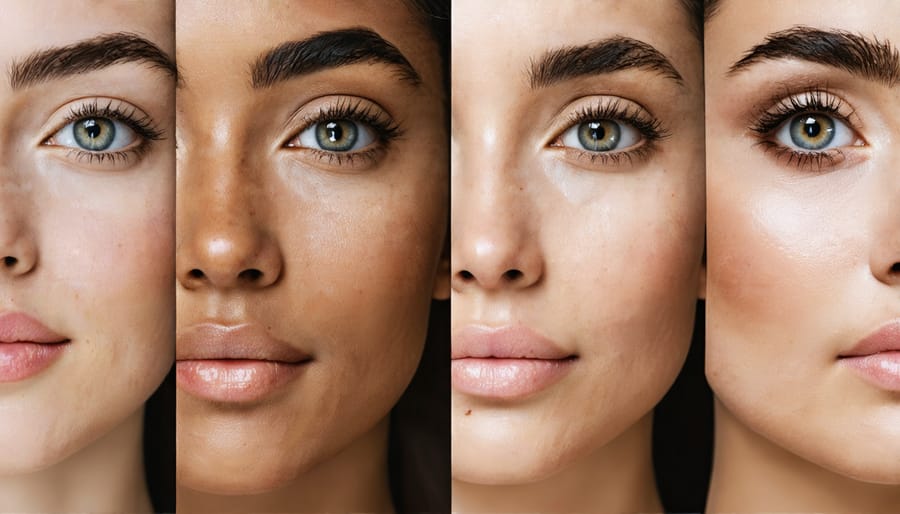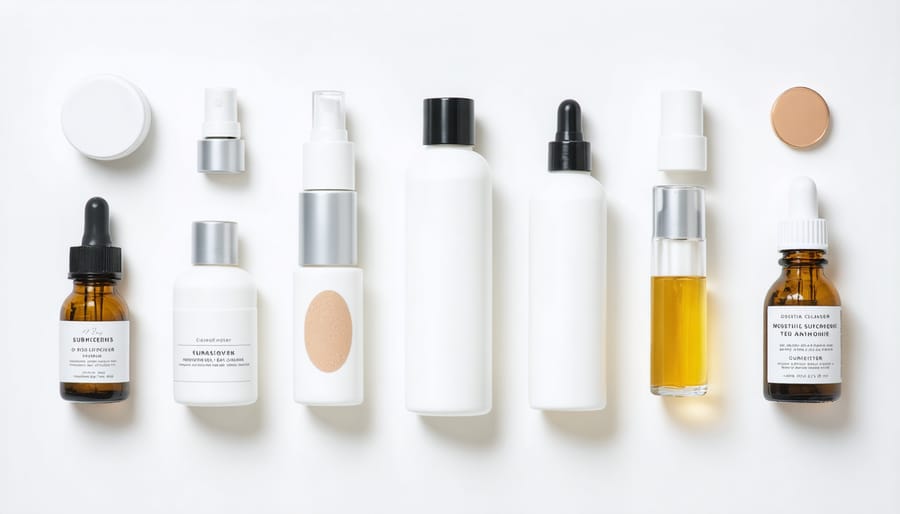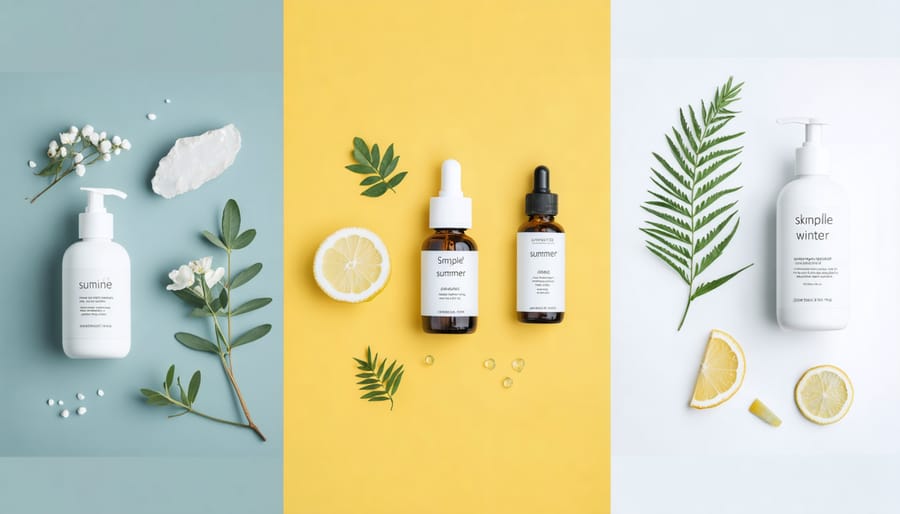
Transform your daily skincare routine from generic to game-changing by understanding the unique characteristics of your skin. Gone are the days of one-size-fits-all solutions – your complexion deserves a tailored approach that evolves with your skin’s changing needs. Whether you’re dealing with sensitivity, aging concerns, or combination challenges, learning to craft your perfect skincare routine starts with careful observation and intentional product selection.
Think of your skincare routine as a personal signature – distinctly yours and perfectly aligned with your skin’s language. Just as no two fingerprints are identical, your skin’s needs are uniquely yours, influenced by factors like genetics, environment, hormones, and lifestyle choices. The beauty of customization lies in its flexibility – your routine can (and should) adapt as your skin changes with seasons, stress levels, and time.
Creating a customized skincare routine isn’t just about following trends; it’s about building a sustainable, effective practice that delivers real results. By taking the time to understand your skin’s specific needs and responses, you’re investing in long-term skin health rather than chasing quick fixes.
Why Your Skin Deserves a Custom Approach
Your Unique Skin Profile
Just like your fingerprint, your skin tells a unique story. Understanding your personal skin profile is the foundation of an effective skincare routine. Start by identifying your basic skin type: oily, dry, combination, or normal. But don’t stop there – your skin is influenced by various factors that make your needs distinctly yours.
Consider your specific concerns: perhaps you’re dealing with occasional breakouts, visible pores, or early signs of aging. Maybe you’ve noticed how nutrition affects skin health and how your skin responds to different foods. Your environment plays a crucial role too – city pollution, humid climates, or dry indoor heating can all impact your skin’s behavior.
Take note of how your skin changes with seasons, stress levels, and hormonal fluctuations. Does it become more sensitive during certain times of the month? Does it react to specific ingredients? These observations are valuable clues in creating your personalized routine.
Remember, your skin profile isn’t static – it evolves with age, lifestyle changes, and even geographic location. Regular assessment helps you adapt your skincare routine to meet your skin’s changing needs.

The Problem with Generic Routines
Have you ever noticed how that “must-try” skincare routine your friend swears by just doesn’t work for you? You’re not alone. Generic skincare advice, while well-intentioned, often falls short because it overlooks one crucial fact: your skin is uniquely yours.
Think of it this way – recommending the same skincare routine for everyone is like suggesting everyone wear the same size shoes. What works wonderfully for dry skin might wreak havoc on oily skin, and products perfect for sensitive skin could be too gentle for those battling stubborn acne.
I learned this the hard way when I jumped on the trending 10-step Korean skincare bandwagon. While it transformed my friend’s complexion, my skin responded with breakouts and irritation. The truth is, following generic routines can lead to overuse of unnecessary products, missed opportunities to address your specific concerns, and even skin damage from using inappropriate ingredients.
The real problem isn’t just wasted time and money – it’s the frustration of not seeing results despite faithfully following “expert” advice. Your skin deserves better than a one-size-fits-all approach.
Building Your Perfect Skincare Routine
Step 1: Analyzing Your Skin
Getting your skincare routine right starts with truly understanding your skin – think of it as becoming your own skin detective! As someone who spent years using the wrong products, I can’t stress enough how important this step is.
Start by examining your bare face in natural daylight, preferably in the morning before applying any products. Press a clean tissue against different areas of your face – your forehead, nose, cheeks, and chin. The amount of oil left on the tissue can help determine if you’re oily, dry, or combination.
Notice how your skin feels throughout the day. Does it get shiny by noon? Does it feel tight and uncomfortable? These are valuable clues about your skin type. Pay attention to specific concerns too – are you dealing with occasional breakouts, dark spots, or fine lines?
Consider external factors that might affect your skin. Climate, stress levels, hormonal changes, and even your diet can all impact your skin’s behavior. Keep a simple skin diary for a week, noting any changes or reactions you observe.
Don’t forget to look at your current products. If any cause irritation, redness, or breakouts, make note of these reactions. This information will be invaluable when selecting new products for your routine.
Remember, your skin type can change with seasons and age, so regular reassessment is key to maintaining an effective skincare routine.

Step 2: Choosing Core Products
Now that you’ve identified your skin type and concerns, it’s time to build your foundation with core skincare products. Think of these as your skincare wardrobe essentials – the must-haves that will do the heavy lifting in your routine.
First up is your cleanser, which sets the stage for everything that follows. If you have dry skin, look for cream or oil-based cleansers that won’t strip your natural moisture. Oily and combination skin types typically do well with gel or foam cleansers that help balance oil production. Those with sensitive skin should opt for gentle, fragrance-free formulations.
Next, consider your treatment products. This is where you’ll address your specific skin concerns. For anti-aging, look for serums containing retinol or peptides. If hyperpigmentation is your concern, vitamin C and niacinamide are your friends. Dealing with acne? Salicylic acid or benzoyl peroxide products should be on your radar.
Don’t forget your moisturizer – it’s non-negotiable regardless of your skin type. Those with oily skin might prefer lightweight gel formulations, while dry skin types can benefit from richer creams. Look for ingredients like hyaluronic acid for hydration, ceramides for barrier support, or squalane for balanced moisture.
Last but certainly not least is sunscreen. This is your best defense against premature aging and skin damage. Choose a broad-spectrum SPF 30 or higher that suits your skin type and lifestyle. If you’re prone to breakouts, look for non-comedogenic formulations.
Remember, you don’t need to incorporate every trending product into your routine. Start with these core products and give them time to work – usually about 4-6 weeks. You can always add more specialized products later, but these basics will form the backbone of your skincare success.
A quick tip from my personal experience: Keep a skincare journal for the first few weeks. Note how your skin responds to each product, and don’t introduce multiple new products at once. This way, you’ll know exactly what works for your unique skin needs.
Step 3: Adding Targeted Treatments
Now that you’ve got your foundation in place, it’s time to address those specific skin concerns that make your skincare journey unique. Think of targeted treatments like retinol and vitamin C as your skincare superheroes, each with their own special powers to tackle different concerns.
Start by identifying your top one or two skin concerns. Maybe you’re noticing fine lines around your eyes, dealing with occasional breakouts, or wanting to fade those stubborn dark spots. Remember, less is more when it comes to treatments – trying to address everything at once can overwhelm your skin.
For dark spots and uneven texture, consider incorporating an exfoliating serum with glycolic or lactic acid, using it 2-3 times a week. If aging is your concern, a retinol product used in the evening can work wonders, but start slowly – once or twice a week – and build up your skin’s tolerance.
For those dealing with acne, look for treatments containing salicylic acid or niacinamide. These ingredients are fantastic at clearing pores and reducing inflammation without being too harsh. If dryness is your battle, hyaluronic acid serums can be your best friend, especially when applied to damp skin.
Here’s a pro tip I’ve learned through my own skincare journey: introduce one new treatment at a time and wait at least two weeks before adding another. This way, you can truly tell what’s working for your skin and what isn’t. Think of it like conducting a little experiment – you want to know exactly which variable is creating those amazing results!
Remember that seasons change, and so does your skin. What works beautifully in winter might be too heavy for summer, so don’t be afraid to adjust your treatment products accordingly. Listen to your skin – it’s surprisingly good at telling you what it needs!
Adapting Your Routine
Seasonal Adjustments
Just like we change our wardrobes with the seasons, our skin needs different care throughout the year. I learned this lesson the hard way when my usual heavy moisturizer left me feeling like an oil slick during a humid summer!
During warmer months, opt for lighter, water-based products that won’t clog your pores. A gel moisturizer and non-comedogenic sunscreen are your best friends here. You might also want to increase your exfoliation frequency slightly to manage excess oil and sweat, but always listen to your skin’s needs.
As temperatures drop, your skin typically needs more hydration and protection. Consider switching to a richer moisturizer and adding facial oils to your routine. Many of us notice our skin becoming more sensitive during winter, so you might want to dial back on active ingredients like retinols and acids.
Spring and fall are transition seasons, perfect for gradually adjusting your routine. These periods are ideal for introducing new products as your skin adapts to changing weather conditions. Keep a close eye on how your skin responds and adjust accordingly.
Remember, seasonal changes don’t always follow the calendar exactly – pay attention to both the weather and your skin’s behavior. Sometimes you’ll need to make adjustments based on sudden weather changes or indoor climate control effects.

Life Changes and Your Skin
Just like life itself, your skin is constantly evolving. Whether you’re burning the midnight oil at work, experiencing pregnancy, or celebrating another trip around the sun, these changes can significantly impact your skin’s needs. Taking a holistic approach to skincare becomes especially important during these transitions.
During stressful periods, you might notice increased breakouts or dullness. This is your skin’s way of telling you it needs extra TLC. Consider incorporating calming ingredients like chamomile or niacinamide, and don’t underestimate the power of a good night’s sleep.
Hormonal changes, whether from your monthly cycle, pregnancy, or menopause, can trigger significant skin transformations. What worked for you last month might not be the best choice today. Listen to your skin and adjust accordingly – perhaps adding more hydration during drier phases or introducing gentle exfoliation when dealing with hormonal breakouts.
As we age, our skin’s needs evolve too. You might notice it becoming drier or more sensitive, requiring richer moisturizers and gentler cleansers. This isn’t about fighting aging – it’s about nurturing your skin through each phase of life.
Remember, these changes aren’t setbacks; they’re opportunities to better understand and care for your skin. Keep a skin journal to track changes and responses to products, and don’t hesitate to adjust your routine as needed. Your skin’s journey is uniquely yours, and embracing these changes is part of developing a truly personalized skincare approach.
My Personal Journey
Like many of you, my skincare journey began with trying countless trending products that promised miracle results. For years, I followed the “one-size-fits-all” routines I found in magazines, only to feel frustrated when my combination skin wouldn’t cooperate. Some days my T-zone would be excessively oily, while my cheeks remained painfully dry.
The turning point came when I decided to take a step back and really understand my skin. I started keeping a skin diary, tracking how my complexion responded to different factors like stress, diet, and seasonal changes. This simple act of paying attention helped me notice patterns I’d never seen before.
Through careful observation and gradual experimentation, I developed a routine that finally worked for my unique needs. I discovered that my skin thrives with a gentle cleanser in the morning, but needs double cleansing at night. While my friends swear by heavy moisturizers, my skin performs better with lightweight, layered hydration.
The results weren’t overnight, but they were transformative. Within three months, my persistent breakouts decreased significantly, and the dry patches that had plagued me for years began to smooth out. Today, my skin isn’t perfect, but it’s healthier and more balanced than ever before. Most importantly, I’ve learned that skincare isn’t about following trends – it’s about listening to your skin and giving it exactly what it needs.
Your skincare journey is as unique as you are, and creating a customized routine is the key to achieving your best skin yet. Remember that building the perfect regimen takes time, patience, and a willingness to listen to your skin’s needs. Start small with the basics – cleanser, moisturizer, and sunscreen – then gradually incorporate targeted treatments that address your specific concerns. Don’t be afraid to adjust your routine as seasons change or when your skin’s needs evolve. The most important thing is to stay consistent and pay attention to how your skin responds. As someone who’s experienced the transformation that comes with a personalized approach to skincare, I encourage you to take that first step today. Your future self (and skin!) will thank you for it. Remember, beautiful skin isn’t about following trends – it’s about finding what works for you.



